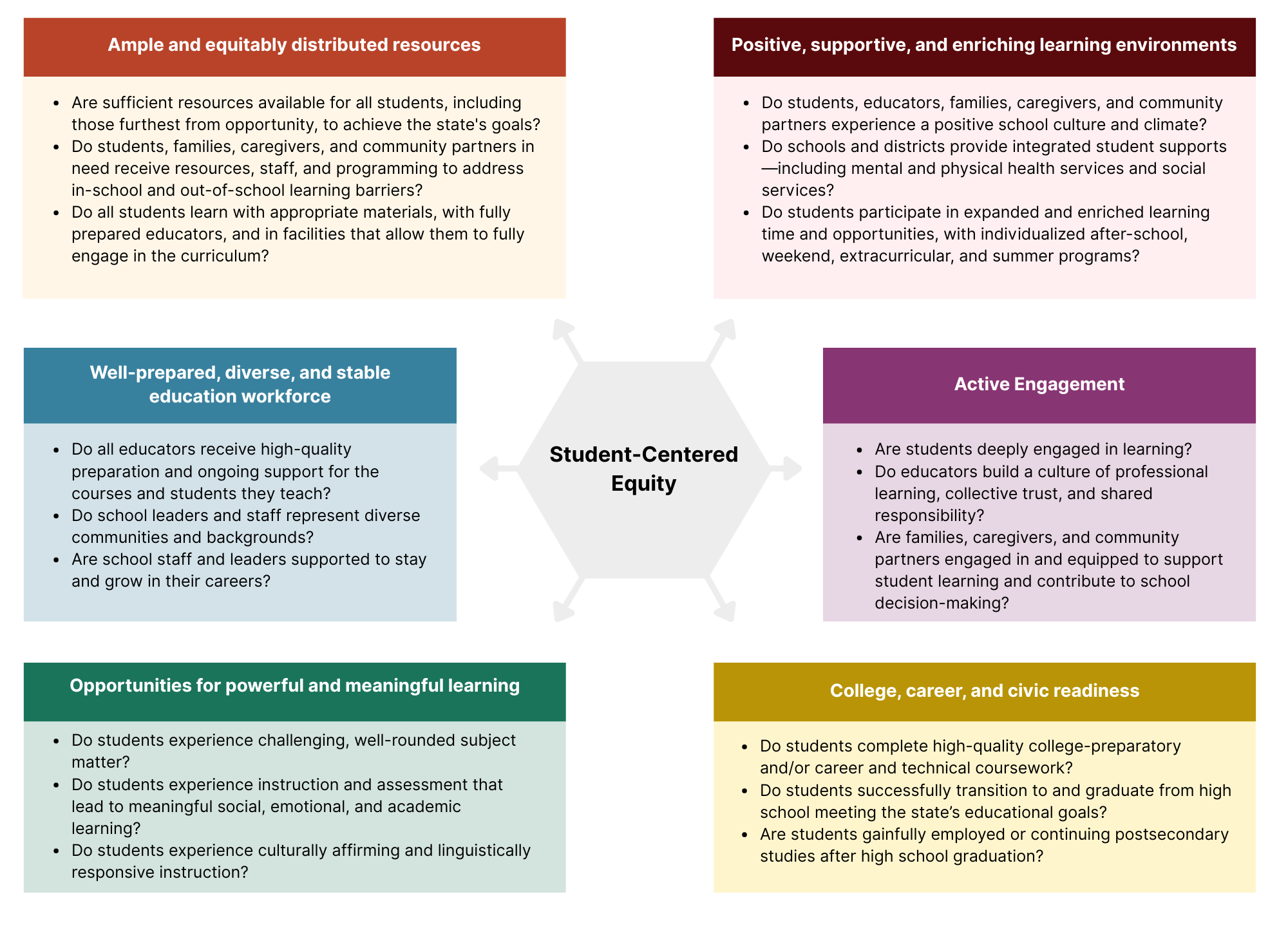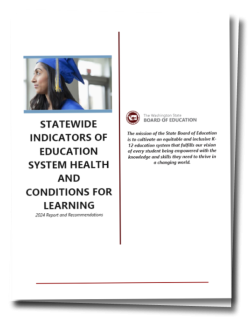The Board is committed to developing an equitable and informative continuous improvement system that provides K–12 education leaders with a comprehensive view of how the state’s K–12 system is performing.
In support of this work, the Board:
-
Collaborated with OSPI and other education partners to release the Washington School Improvement Framework (WSIF) in March 2018. The WSIF identifies how schools can improve the education of all students through annually measuring multiple indicators. It is part of the state’s Every Student Succeeds Act plan approved by the U.S. Department of Education.
-
Approves required action plans submitted by school districts that OSPI has identified as low-achieving required action districts (RCW 28A.657.060).
-
Monitors Washington’s overall K-12 educational system health by reporting on key indicators that:
-
Comprehensively describe the quality of the state’s learning environments and
-
Inform the actions needed to ensure that the system operates effectively and equitably.
-
Recommends evidence-based reforms to the legislature to improve educational outcomes. (RCW 28A.150.550)
-
Measuring Educational System Health
The Legislature established a set of six Indicators of Educational System Health to measure the performance of the State’s K-12 system. In collaboration with education partners, the Board is responsible for measuring and setting realistic but challenging performance goals and targets for each statewide indicator.
Every even year, the Board evaluates the state’s progress in meeting these performance goals and prepares a report for the Legislature. The report also includes comparisons to national and peer state performance data and, if necessary, recommends revised goals and targets or evidence-based reforms.
In December 2024, the Board submitted its seventh report on the Indicators of Educational System Health to the Governor’s Office and the Educational Committees of the Legislature.
2024 Report Findings
| Indicator | How it's Measured | Most Recent School Year | Most Recent Data | Met the Reset Annual Target? |
|---|---|---|---|---|
| Kindergarten Readiness | Percentage of students who demonstrate the characteristics of entering kindergarteners in all six domains of the WA Kindergarten Inventory of Developing Skills (WA KIDS). | 2024 | 57.9% | No |
| 4th Grade Reading | Percentage of students Meeting or Exceeding standard on the 4th Grade statewide reading assessment. | 2024 | 48.5% | No |
| 8th Grade Math | Percentage of students Meeting or Exceeding standard on the 8th Grade statewide math assessment. | 2024 | 33.5% | No |
| High School Graduation Rate |
The percentage of students graduating using the On-Time (4-Vear) adjusted cohort graduation rate (ACGR). |
2023 | 83.6% | Yes |
| Readiness for College Coursework (4-Year)* | The percentage of high school graduates who enroll in public post-secondary institutions and are not required to take precollege or remedial courses in English or math. | 2021 | 92% | Yes |
| Readiness for College Coursework (2-Year)* | The percentage of high school graduates who enroll in public post-secondary institutions and are not required to take precollege or remedial courses in English or math. | 2021 | 78% | Yes |
|
Post-Secondary Engagement (Q2)* |
Percentage of high school graduates who are enrolled in postsecondary education, training or are employed in the 2nd and 4th quarters after graduation. |
2021 | 77.4% | No |
|
Post-Secondary Engagement (Q4)* |
Percentage of high school graduates who are enrolled in postsecondary education, training or are employed in the 2nd and 4th quarters after graduation. |
2021 | 78.2% | No |
*Note: The last two measures, “Readiness for College Coursework” and “Post-Secondary Engagement” are each separated into two sub-measures as shown in the chart. In addition, these metrics are disaggregated by race, low income, highly capable, transitional bilingual, migrant, special education, and students covered by section 504 of the federal rehabilitation act of 1973.
Past Educational System Health Reports
A More Equitable and Comprehensive Educational System Health Framework
While the six Indicators of Educational System Health offer a high-level view of the educational system's condition, they do not capture its full complexity. For a more equitable and comprehensive assessment of Washington’s educational system, the Board is expanding upon the legislatively created indicators to include input and process measures that collectively define “conditions for learning” and better describe the quality of our learning environments.
Rather than focusing on whether a limited set of student outcome goals are being met, as past systems have done, the new approach will provide cohesive information about the resources being provided, how students are experiencing learning, and students’ progress toward more robust and meaningful measures. The new framework will help the state identify actions that ensure the system is operating effectively and equitably and support students to better meet the state’s basic education goals specified in RCW 28A.150.210.
The new comprehensive educational system health framework will continue to measure the 6 legislatively required indicators as part of a larger set of 18 possible indicators that support continuous improvement.

Additional Resources
- Continuous Improvement and Recognition System Revisioning Process Report
- Using Indicators & Measures of School Climate and Conditions for Learning Memo
- Designing New Accountability, Recognition, and Improvement Practices for Washington
- Recording of webinar held with partner organizations
- Recording of webinar held with SBE's Technical Advisory Committee
- Recording of Learning Policy Institute presentation to the Educational Opportunity Gap Oversight and Accountability Committee (EOGOAC)


